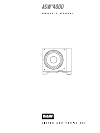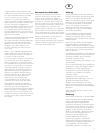
6
Introduction
Thank you for purchasing the B&W ASW
™
4000
Active Subwoofer.
Since its foundation in 1966, the continuing
philosophy of B&W has been the quest for
perfect sound reproduction. Inspired by the
company’s founder, the late John Bowers, this
quest has entailed not only high investment in
audio technology and innovation but also an
abiding appreciation of music and the demands
of film sound to ensure that the technology is put
to maximum effect.
The ASW
™
4000 has been designed for Home
Theatre installations and to augment the bass
performance of ‘full range’ speakers in stereo
audio use. Adding the subwoofer to your
system not only extends the bass to lower
frequencies, it improves the midrange clarity
by reducing the low-frequency demands on
your existing speakers.
The subwoofer is magnetically shielded for use
close to a television screen.
Please read through this manual fully before
using the subwoofer. All sound installations
require some planning and experimentation if
you are to get the best out of the products used
and this manual will guide you in this process.
As the subwoofer is connected to the electricity
power supply, it is important that you familiarise
yourself with the safety instructions and heed
all warnings.
Keep this manual in a safe place for future
reference.
B&W loudspeakers are distributed to over 60
countries world-wide and we maintain an
international network of carefully chosen and
dedicated distributors. If you have a problem
which your dealer cannot resolve, our distributors
will be more than willing to assist you.
Unpacking (figure 1)
The easiest way to unpack the subwoofer and
avoid damage is as follows:
• Open the carton flaps right back and invert
the carton and contents.
• Lift the carton away from the product.
• We recommend that you retain the packaging
for future use.
In addition to this manual, the carton
should contain:
• 1 Subwoofer
• 1 Accessory pack containing:
•
4 Spikes with lock nuts
•
4 Self-adhesive rubber feet
• 1 Phono ‘T’-splitter plug
A tour of the subwoofer (figure 2)
1 Heatsink
2 Line level connectors
3 Speaker level connectors
4 Low-pass filter frequency control (line input)
5 Volume control (line input)
6 Decoder input
7 Volume control (decoder input)
8 Equalisation switch (decoder input)
9 Phase switch
10 On/Auto/Off switch
11 Mains input socket
12 Voltage selector/indicator
13 Fuseholder
14 Power/Standby indicator
15 Toroidal mains transformer housing
Positioning the subwoofer
Because the subwoofer produces only low-
frequency sounds, positioning is less critical in
some respects compared with full-range speakers.
Directional information is much less precise and
you have more choice where to place the
speakers to good effect. This said, best results
are obtained if the subwoofer is placed between
the satellite speakers or in the vicinity of one of
them. If you use two subwoofers, it is best to put
one near each satellite speaker.
Placing the subwoofer behind the listeners, even
in surround sound installations, generally gives
inferior imaging; but may be an acceptable
compromise if domestic considerations dictate.
As with all speakers, the proximity of room
boundaries affects the sound. Bass is generally
increased as more surfaces come into close
proximity with the speakers. Unlike full-range
speakers, however, you can always restore the
correct overall system balance by adjusting the
volume level of the subwoofer. The more boost
you get from the room, the less hard the speaker
has to work; but there is a down side. Corner
positions often excite more low-frequency room
resonances, making the bass more uneven with
frequency. There is no substitute for experiment
as all rooms behave differently, so try the
subwoofer in a variety of positions before
making a final decision. A piece of music with
a bass line ascending or descending the musical
scale is useful for assessing the smoothness of
the bass response. Listen for exaggerated or
quiet notes. Having a separate subwoofer does
enable you to optimise for room resonances
independently from siting the satellite speakers
for best imaging.
If the subwoofer is to be used in a confined
space (eg in custom furniture), the space must
be ventilated to allow sufficient air to circulate
and cool the unit. Ask your dealer for advice.
The subwoofer is supplied with four spike feet.
The spikes pierce through carpet pile, giving a
firm support directly to the floor surface without
crushing the pile. When fitting spikes, first screw
the lock nuts fully onto the spikes, then screw
the spikes fully onto the threaded inserts in the
base of the cabinet. If the unit rocks, loosen the
relevant two opposing spikes until the support is
firm, then re-tighten the lock nuts to the inserts.
If the unit is to be placed on a vulnerable surface,
either place a protective disc under each spike
or fit the four rubber pads in place of the spikes.
Electrical connections
Disconnect all sound system equipment from the
power supply until the signal connections have
been made and checked. This avoids the risk of
damage whilst connections are made or broken.
The function of the subwoofer is to receive
signals from the amplification chain and, where
necessary split the signal into low bass and
higher frequencies and feed the latter back out
to the satellite speakers. Left and right channel
inputs may be combined into a single mono low
bass feed to the subwoofer drive unit if required.
The subwoofer will input and output both line
level signals via the RCA Phono sockets and
speaker level signals via the binding posts
located on the back panel, giving a flexible
choice of connection methods. However, you
must not use a mixture of line level and speaker
level connections in the same installation. If you
have a choice between line level and speaker
level connections, choose line level.
The subwoofer also has a dedicated decoder
input, which is automatically selected if a signal
is present on this input. If no signal is detected
on this input for approximately 20 seconds, the
subwoofer will switch to the line/speaker level
inputs.
Decoder volume and equalisation are set by
separate controls from the line and speaker
inputs, for ease of installation.
Use the following table to select the correct
wiring method for your installation:
Application: Home Theatre
• Decoder with separate power amplifiers:
a With subwoofer output: Connections: fig. 3
b No subwoofer output: Connections: fig. 4
• Decoder with integrated power amplifiers:
a With subwoofer output: Connections: fig. 5
b No subwoofer output: Connections: fig. 6
Application: Stereo Audio
Separate pre- & power amplifiers:
a One or more subwoofers with output
combined into a single mono signal:
Connections: fig. 7
b Two subwoofers with separate left and right
signals: Connections: fig. 8
• Integrated amplifier:
a One or more subwoofers with output
combined into a single mono signal:
Connections: fig. 9
b Two subwoofers with separate left and
right signals: Connections: fig. 10
Using more than one subwoofer
Using more than one unit in a single installation
can improve performance in the following ways:


















